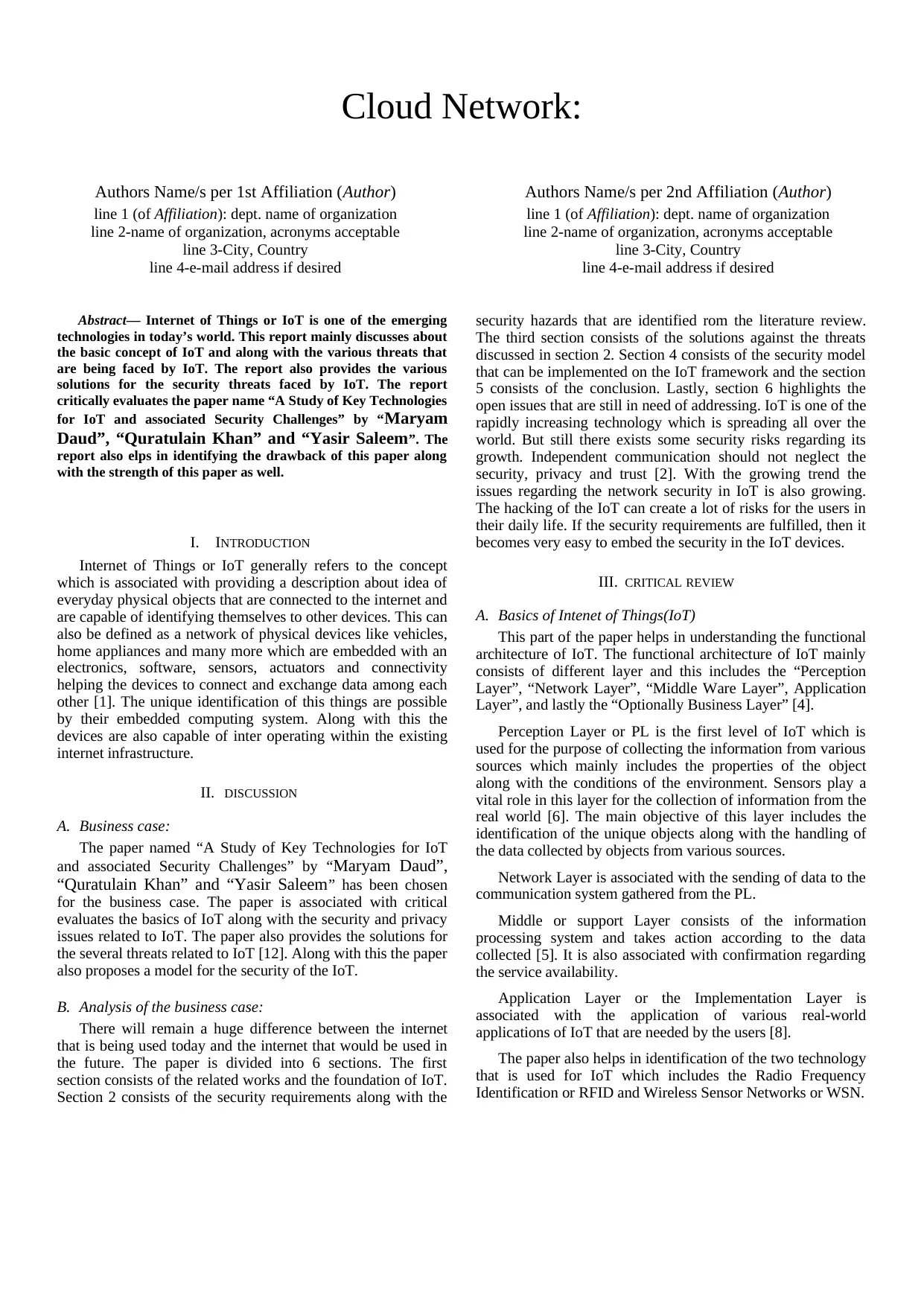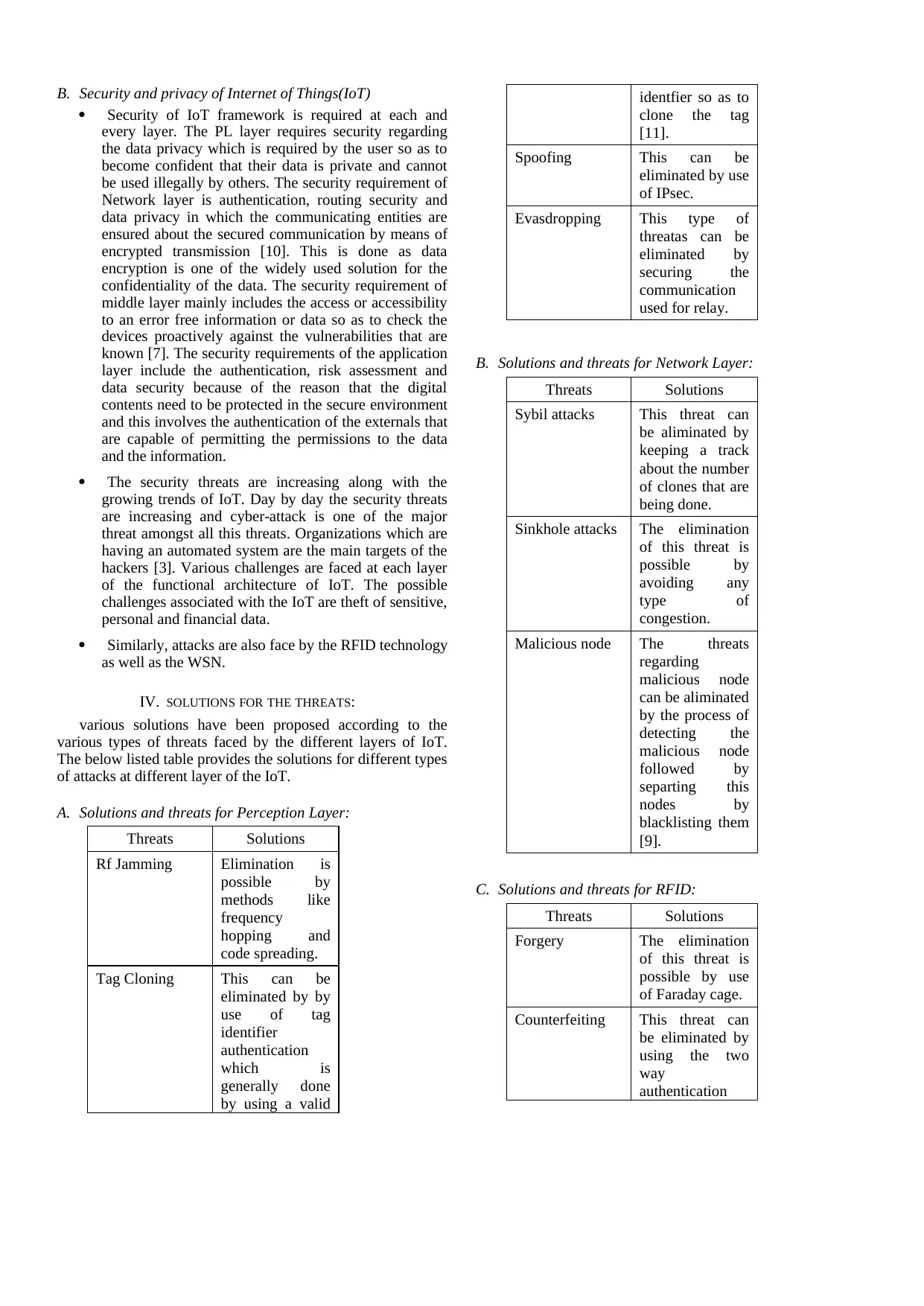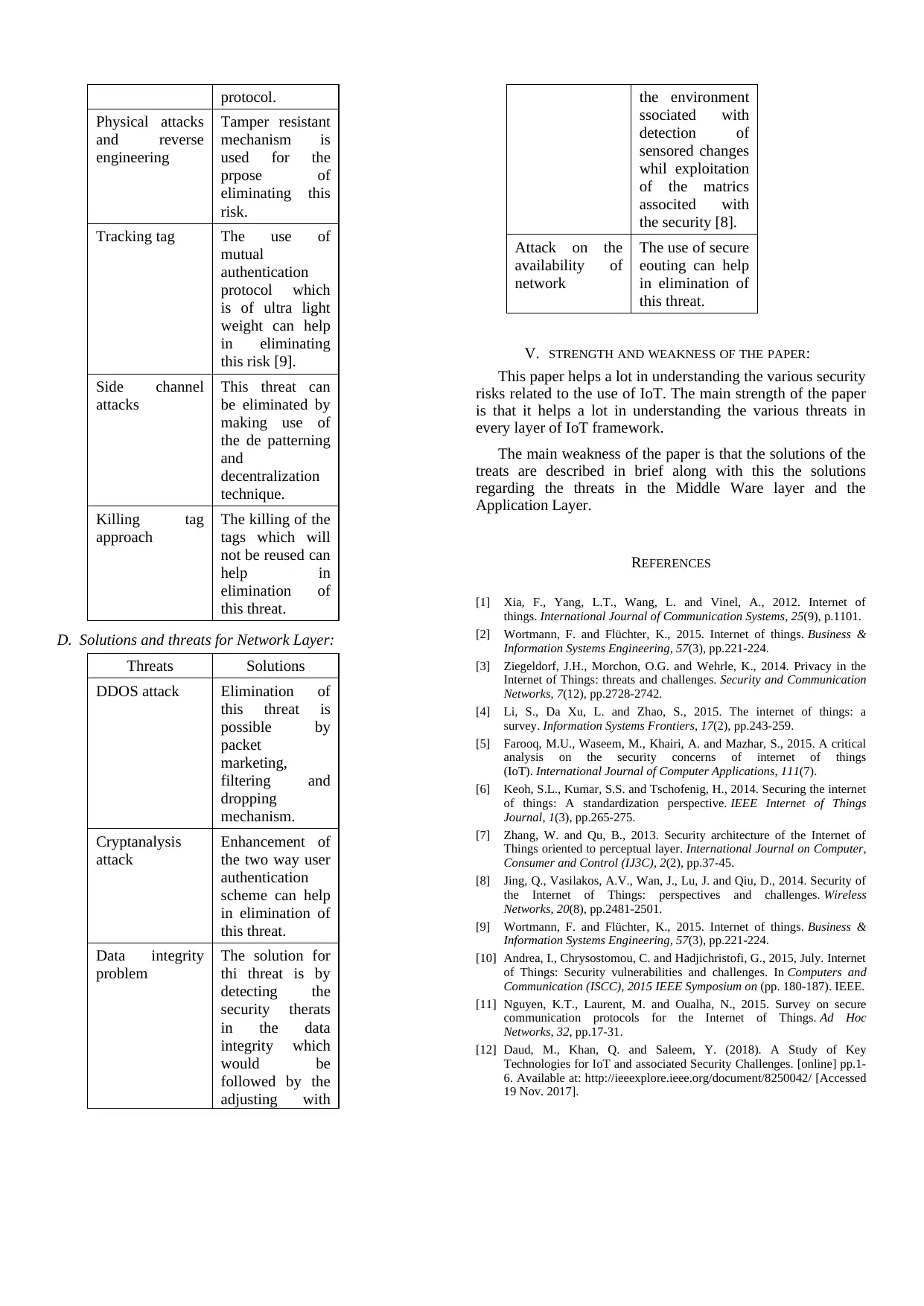Internet of Things Security Challenges
VerifiedAdded on 2020/05/16
|4
|2494
|81
AI Summary
The assignment delves into the pressing security challenges faced by the Internet of Things (IoT). It examines vulnerabilities stemming from diverse sources, including privacy breaches, inadequate standardization practices, and potential attack vectors. The provided references highlight key research articles discussing these concerns, emphasizing the need for robust security measures in IoT ecosystems.
Contribute Materials
Your contribution can guide someone’s learning journey. Share your
documents today.

Cloud Network:
Authors Name/s per 1st Affiliation (Author)
line 1 (of Affiliation): dept. name of organization
line 2-name of organization, acronyms acceptable
line 3-City, Country
line 4-e-mail address if desired
Authors Name/s per 2nd Affiliation (Author)
line 1 (of Affiliation): dept. name of organization
line 2-name of organization, acronyms acceptable
line 3-City, Country
line 4-e-mail address if desired
Abstract— Internet of Things or IoT is one of the emerging
technologies in today’s world. This report mainly discusses about
the basic concept of IoT and along with the various threats that
are being faced by IoT. The report also provides the various
solutions for the security threats faced by IoT. The report
critically evaluates the paper name “A Study of Key Technologies
for IoT and associated Security Challenges” by “Maryam
Daud”, “Quratulain Khan” and “Yasir Saleem”. The
report also elps in identifying the drawback of this paper along
with the strength of this paper as well.
I. INTRODUCTION
Internet of Things or IoT generally refers to the concept
which is associated with providing a description about idea of
everyday physical objects that are connected to the internet and
are capable of identifying themselves to other devices. This can
also be defined as a network of physical devices like vehicles,
home appliances and many more which are embedded with an
electronics, software, sensors, actuators and connectivity
helping the devices to connect and exchange data among each
other [1]. The unique identification of this things are possible
by their embedded computing system. Along with this the
devices are also capable of inter operating within the existing
internet infrastructure.
II. DISCUSSION
A. Business case:
The paper named “A Study of Key Technologies for IoT
and associated Security Challenges” by “Maryam Daud”,
“Quratulain Khan” and “Yasir Saleem” has been chosen
for the business case. The paper is associated with critical
evaluates the basics of IoT along with the security and privacy
issues related to IoT. The paper also provides the solutions for
the several threats related to IoT [12]. Along with this the paper
also proposes a model for the security of the IoT.
B. Analysis of the business case:
There will remain a huge difference between the internet
that is being used today and the internet that would be used in
the future. The paper is divided into 6 sections. The first
section consists of the related works and the foundation of IoT.
Section 2 consists of the security requirements along with the
security hazards that are identified rom the literature review.
The third section consists of the solutions against the threats
discussed in section 2. Section 4 consists of the security model
that can be implemented on the IoT framework and the section
5 consists of the conclusion. Lastly, section 6 highlights the
open issues that are still in need of addressing. IoT is one of the
rapidly increasing technology which is spreading all over the
world. But still there exists some security risks regarding its
growth. Independent communication should not neglect the
security, privacy and trust [2]. With the growing trend the
issues regarding the network security in IoT is also growing.
The hacking of the IoT can create a lot of risks for the users in
their daily life. If the security requirements are fulfilled, then it
becomes very easy to embed the security in the IoT devices.
III. CRITICAL REVIEW
A. Basics of Intenet of Things(IoT)
This part of the paper helps in understanding the functional
architecture of IoT. The functional architecture of IoT mainly
consists of different layer and this includes the “Perception
Layer”, “Network Layer”, “Middle Ware Layer”, Application
Layer”, and lastly the “Optionally Business Layer” [4].
Perception Layer or PL is the first level of IoT which is
used for the purpose of collecting the information from various
sources which mainly includes the properties of the object
along with the conditions of the environment. Sensors play a
vital role in this layer for the collection of information from the
real world [6]. The main objective of this layer includes the
identification of the unique objects along with the handling of
the data collected by objects from various sources.
Network Layer is associated with the sending of data to the
communication system gathered from the PL.
Middle or support Layer consists of the information
processing system and takes action according to the data
collected [5]. It is also associated with confirmation regarding
the service availability.
Application Layer or the Implementation Layer is
associated with the application of various real-world
applications of IoT that are needed by the users [8].
The paper also helps in identification of the two technology
that is used for IoT which includes the Radio Frequency
Identification or RFID and Wireless Sensor Networks or WSN.
Authors Name/s per 1st Affiliation (Author)
line 1 (of Affiliation): dept. name of organization
line 2-name of organization, acronyms acceptable
line 3-City, Country
line 4-e-mail address if desired
Authors Name/s per 2nd Affiliation (Author)
line 1 (of Affiliation): dept. name of organization
line 2-name of organization, acronyms acceptable
line 3-City, Country
line 4-e-mail address if desired
Abstract— Internet of Things or IoT is one of the emerging
technologies in today’s world. This report mainly discusses about
the basic concept of IoT and along with the various threats that
are being faced by IoT. The report also provides the various
solutions for the security threats faced by IoT. The report
critically evaluates the paper name “A Study of Key Technologies
for IoT and associated Security Challenges” by “Maryam
Daud”, “Quratulain Khan” and “Yasir Saleem”. The
report also elps in identifying the drawback of this paper along
with the strength of this paper as well.
I. INTRODUCTION
Internet of Things or IoT generally refers to the concept
which is associated with providing a description about idea of
everyday physical objects that are connected to the internet and
are capable of identifying themselves to other devices. This can
also be defined as a network of physical devices like vehicles,
home appliances and many more which are embedded with an
electronics, software, sensors, actuators and connectivity
helping the devices to connect and exchange data among each
other [1]. The unique identification of this things are possible
by their embedded computing system. Along with this the
devices are also capable of inter operating within the existing
internet infrastructure.
II. DISCUSSION
A. Business case:
The paper named “A Study of Key Technologies for IoT
and associated Security Challenges” by “Maryam Daud”,
“Quratulain Khan” and “Yasir Saleem” has been chosen
for the business case. The paper is associated with critical
evaluates the basics of IoT along with the security and privacy
issues related to IoT. The paper also provides the solutions for
the several threats related to IoT [12]. Along with this the paper
also proposes a model for the security of the IoT.
B. Analysis of the business case:
There will remain a huge difference between the internet
that is being used today and the internet that would be used in
the future. The paper is divided into 6 sections. The first
section consists of the related works and the foundation of IoT.
Section 2 consists of the security requirements along with the
security hazards that are identified rom the literature review.
The third section consists of the solutions against the threats
discussed in section 2. Section 4 consists of the security model
that can be implemented on the IoT framework and the section
5 consists of the conclusion. Lastly, section 6 highlights the
open issues that are still in need of addressing. IoT is one of the
rapidly increasing technology which is spreading all over the
world. But still there exists some security risks regarding its
growth. Independent communication should not neglect the
security, privacy and trust [2]. With the growing trend the
issues regarding the network security in IoT is also growing.
The hacking of the IoT can create a lot of risks for the users in
their daily life. If the security requirements are fulfilled, then it
becomes very easy to embed the security in the IoT devices.
III. CRITICAL REVIEW
A. Basics of Intenet of Things(IoT)
This part of the paper helps in understanding the functional
architecture of IoT. The functional architecture of IoT mainly
consists of different layer and this includes the “Perception
Layer”, “Network Layer”, “Middle Ware Layer”, Application
Layer”, and lastly the “Optionally Business Layer” [4].
Perception Layer or PL is the first level of IoT which is
used for the purpose of collecting the information from various
sources which mainly includes the properties of the object
along with the conditions of the environment. Sensors play a
vital role in this layer for the collection of information from the
real world [6]. The main objective of this layer includes the
identification of the unique objects along with the handling of
the data collected by objects from various sources.
Network Layer is associated with the sending of data to the
communication system gathered from the PL.
Middle or support Layer consists of the information
processing system and takes action according to the data
collected [5]. It is also associated with confirmation regarding
the service availability.
Application Layer or the Implementation Layer is
associated with the application of various real-world
applications of IoT that are needed by the users [8].
The paper also helps in identification of the two technology
that is used for IoT which includes the Radio Frequency
Identification or RFID and Wireless Sensor Networks or WSN.
Secure Best Marks with AI Grader
Need help grading? Try our AI Grader for instant feedback on your assignments.

B. Security and privacy of Internet of Things(IoT)
Security of IoT framework is required at each and
every layer. The PL layer requires security regarding
the data privacy which is required by the user so as to
become confident that their data is private and cannot
be used illegally by others. The security requirement of
Network layer is authentication, routing security and
data privacy in which the communicating entities are
ensured about the secured communication by means of
encrypted transmission [10]. This is done as data
encryption is one of the widely used solution for the
confidentiality of the data. The security requirement of
middle layer mainly includes the access or accessibility
to an error free information or data so as to check the
devices proactively against the vulnerabilities that are
known [7]. The security requirements of the application
layer include the authentication, risk assessment and
data security because of the reason that the digital
contents need to be protected in the secure environment
and this involves the authentication of the externals that
are capable of permitting the permissions to the data
and the information.
The security threats are increasing along with the
growing trends of IoT. Day by day the security threats
are increasing and cyber-attack is one of the major
threat amongst all this threats. Organizations which are
having an automated system are the main targets of the
hackers [3]. Various challenges are faced at each layer
of the functional architecture of IoT. The possible
challenges associated with the IoT are theft of sensitive,
personal and financial data.
Similarly, attacks are also face by the RFID technology
as well as the WSN.
IV. SOLUTIONS FOR THE THREATS:
various solutions have been proposed according to the
various types of threats faced by the different layers of IoT.
The below listed table provides the solutions for different types
of attacks at different layer of the IoT.
A. Solutions and threats for Perception Layer:
Threats Solutions
Rf Jamming Elimination is
possible by
methods like
frequency
hopping and
code spreading.
Tag Cloning This can be
eliminated by by
use of tag
identifier
authentication
which is
generally done
by using a valid
identfier so as to
clone the tag
[11].
Spoofing This can be
eliminated by use
of IPsec.
Evasdropping This type of
threatas can be
eliminated by
securing the
communication
used for relay.
B. Solutions and threats for Network Layer:
Threats Solutions
Sybil attacks This threat can
be aliminated by
keeping a track
about the number
of clones that are
being done.
Sinkhole attacks The elimination
of this threat is
possible by
avoiding any
type of
congestion.
Malicious node The threats
regarding
malicious node
can be aliminated
by the process of
detecting the
malicious node
followed by
separting this
nodes by
blacklisting them
[9].
C. Solutions and threats for RFID:
Threats Solutions
Forgery The elimination
of this threat is
possible by use
of Faraday cage.
Counterfeiting This threat can
be eliminated by
using the two
way
authentication
Security of IoT framework is required at each and
every layer. The PL layer requires security regarding
the data privacy which is required by the user so as to
become confident that their data is private and cannot
be used illegally by others. The security requirement of
Network layer is authentication, routing security and
data privacy in which the communicating entities are
ensured about the secured communication by means of
encrypted transmission [10]. This is done as data
encryption is one of the widely used solution for the
confidentiality of the data. The security requirement of
middle layer mainly includes the access or accessibility
to an error free information or data so as to check the
devices proactively against the vulnerabilities that are
known [7]. The security requirements of the application
layer include the authentication, risk assessment and
data security because of the reason that the digital
contents need to be protected in the secure environment
and this involves the authentication of the externals that
are capable of permitting the permissions to the data
and the information.
The security threats are increasing along with the
growing trends of IoT. Day by day the security threats
are increasing and cyber-attack is one of the major
threat amongst all this threats. Organizations which are
having an automated system are the main targets of the
hackers [3]. Various challenges are faced at each layer
of the functional architecture of IoT. The possible
challenges associated with the IoT are theft of sensitive,
personal and financial data.
Similarly, attacks are also face by the RFID technology
as well as the WSN.
IV. SOLUTIONS FOR THE THREATS:
various solutions have been proposed according to the
various types of threats faced by the different layers of IoT.
The below listed table provides the solutions for different types
of attacks at different layer of the IoT.
A. Solutions and threats for Perception Layer:
Threats Solutions
Rf Jamming Elimination is
possible by
methods like
frequency
hopping and
code spreading.
Tag Cloning This can be
eliminated by by
use of tag
identifier
authentication
which is
generally done
by using a valid
identfier so as to
clone the tag
[11].
Spoofing This can be
eliminated by use
of IPsec.
Evasdropping This type of
threatas can be
eliminated by
securing the
communication
used for relay.
B. Solutions and threats for Network Layer:
Threats Solutions
Sybil attacks This threat can
be aliminated by
keeping a track
about the number
of clones that are
being done.
Sinkhole attacks The elimination
of this threat is
possible by
avoiding any
type of
congestion.
Malicious node The threats
regarding
malicious node
can be aliminated
by the process of
detecting the
malicious node
followed by
separting this
nodes by
blacklisting them
[9].
C. Solutions and threats for RFID:
Threats Solutions
Forgery The elimination
of this threat is
possible by use
of Faraday cage.
Counterfeiting This threat can
be eliminated by
using the two
way
authentication

protocol.
Physical attacks
and reverse
engineering
Tamper resistant
mechanism is
used for the
prpose of
eliminating this
risk.
Tracking tag The use of
mutual
authentication
protocol which
is of ultra light
weight can help
in eliminating
this risk [9].
Side channel
attacks
This threat can
be eliminated by
making use of
the de patterning
and
decentralization
technique.
Killing tag
approach
The killing of the
tags which will
not be reused can
help in
elimination of
this threat.
D. Solutions and threats for Network Layer:
Threats Solutions
DDOS attack Elimination of
this threat is
possible by
packet
marketing,
filtering and
dropping
mechanism.
Cryptanalysis
attack
Enhancement of
the two way user
authentication
scheme can help
in elimination of
this threat.
Data integrity
problem
The solution for
thi threat is by
detecting the
security therats
in the data
integrity which
would be
followed by the
adjusting with
the environment
ssociated with
detection of
sensored changes
whil exploitation
of the matrics
associted with
the security [8].
Attack on the
availability of
network
The use of secure
eouting can help
in elimination of
this threat.
V. STRENGTH AND WEAKNESS OF THE PAPER:
This paper helps a lot in understanding the various security
risks related to the use of IoT. The main strength of the paper
is that it helps a lot in understanding the various threats in
every layer of IoT framework.
The main weakness of the paper is that the solutions of the
treats are described in brief along with this the solutions
regarding the threats in the Middle Ware layer and the
Application Layer.
REFERENCES
[1] Xia, F., Yang, L.T., Wang, L. and Vinel, A., 2012. Internet of
things. International Journal of Communication Systems, 25(9), p.1101.
[2] Wortmann, F. and Flüchter, K., 2015. Internet of things. Business &
Information Systems Engineering, 57(3), pp.221-224.
[3] Ziegeldorf, J.H., Morchon, O.G. and Wehrle, K., 2014. Privacy in the
Internet of Things: threats and challenges. Security and Communication
Networks, 7(12), pp.2728-2742.
[4] Li, S., Da Xu, L. and Zhao, S., 2015. The internet of things: a
survey. Information Systems Frontiers, 17(2), pp.243-259.
[5] Farooq, M.U., Waseem, M., Khairi, A. and Mazhar, S., 2015. A critical
analysis on the security concerns of internet of things
(IoT). International Journal of Computer Applications, 111(7).
[6] Keoh, S.L., Kumar, S.S. and Tschofenig, H., 2014. Securing the internet
of things: A standardization perspective. IEEE Internet of Things
Journal, 1(3), pp.265-275.
[7] Zhang, W. and Qu, B., 2013. Security architecture of the Internet of
Things oriented to perceptual layer. International Journal on Computer,
Consumer and Control (IJ3C), 2(2), pp.37-45.
[8] Jing, Q., Vasilakos, A.V., Wan, J., Lu, J. and Qiu, D., 2014. Security of
the Internet of Things: perspectives and challenges. Wireless
Networks, 20(8), pp.2481-2501.
[9] Wortmann, F. and Flüchter, K., 2015. Internet of things. Business &
Information Systems Engineering, 57(3), pp.221-224.
[10] Andrea, I., Chrysostomou, C. and Hadjichristofi, G., 2015, July. Internet
of Things: Security vulnerabilities and challenges. In Computers and
Communication (ISCC), 2015 IEEE Symposium on (pp. 180-187). IEEE.
[11] Nguyen, K.T., Laurent, M. and Oualha, N., 2015. Survey on secure
communication protocols for the Internet of Things. Ad Hoc
Networks, 32, pp.17-31.
[12] Daud, M., Khan, Q. and Saleem, Y. (2018). A Study of Key
Technologies for IoT and associated Security Challenges. [online] pp.1-
6. Available at: http://ieeexplore.ieee.org/document/8250042/ [Accessed
19 Nov. 2017].
Physical attacks
and reverse
engineering
Tamper resistant
mechanism is
used for the
prpose of
eliminating this
risk.
Tracking tag The use of
mutual
authentication
protocol which
is of ultra light
weight can help
in eliminating
this risk [9].
Side channel
attacks
This threat can
be eliminated by
making use of
the de patterning
and
decentralization
technique.
Killing tag
approach
The killing of the
tags which will
not be reused can
help in
elimination of
this threat.
D. Solutions and threats for Network Layer:
Threats Solutions
DDOS attack Elimination of
this threat is
possible by
packet
marketing,
filtering and
dropping
mechanism.
Cryptanalysis
attack
Enhancement of
the two way user
authentication
scheme can help
in elimination of
this threat.
Data integrity
problem
The solution for
thi threat is by
detecting the
security therats
in the data
integrity which
would be
followed by the
adjusting with
the environment
ssociated with
detection of
sensored changes
whil exploitation
of the matrics
associted with
the security [8].
Attack on the
availability of
network
The use of secure
eouting can help
in elimination of
this threat.
V. STRENGTH AND WEAKNESS OF THE PAPER:
This paper helps a lot in understanding the various security
risks related to the use of IoT. The main strength of the paper
is that it helps a lot in understanding the various threats in
every layer of IoT framework.
The main weakness of the paper is that the solutions of the
treats are described in brief along with this the solutions
regarding the threats in the Middle Ware layer and the
Application Layer.
REFERENCES
[1] Xia, F., Yang, L.T., Wang, L. and Vinel, A., 2012. Internet of
things. International Journal of Communication Systems, 25(9), p.1101.
[2] Wortmann, F. and Flüchter, K., 2015. Internet of things. Business &
Information Systems Engineering, 57(3), pp.221-224.
[3] Ziegeldorf, J.H., Morchon, O.G. and Wehrle, K., 2014. Privacy in the
Internet of Things: threats and challenges. Security and Communication
Networks, 7(12), pp.2728-2742.
[4] Li, S., Da Xu, L. and Zhao, S., 2015. The internet of things: a
survey. Information Systems Frontiers, 17(2), pp.243-259.
[5] Farooq, M.U., Waseem, M., Khairi, A. and Mazhar, S., 2015. A critical
analysis on the security concerns of internet of things
(IoT). International Journal of Computer Applications, 111(7).
[6] Keoh, S.L., Kumar, S.S. and Tschofenig, H., 2014. Securing the internet
of things: A standardization perspective. IEEE Internet of Things
Journal, 1(3), pp.265-275.
[7] Zhang, W. and Qu, B., 2013. Security architecture of the Internet of
Things oriented to perceptual layer. International Journal on Computer,
Consumer and Control (IJ3C), 2(2), pp.37-45.
[8] Jing, Q., Vasilakos, A.V., Wan, J., Lu, J. and Qiu, D., 2014. Security of
the Internet of Things: perspectives and challenges. Wireless
Networks, 20(8), pp.2481-2501.
[9] Wortmann, F. and Flüchter, K., 2015. Internet of things. Business &
Information Systems Engineering, 57(3), pp.221-224.
[10] Andrea, I., Chrysostomou, C. and Hadjichristofi, G., 2015, July. Internet
of Things: Security vulnerabilities and challenges. In Computers and
Communication (ISCC), 2015 IEEE Symposium on (pp. 180-187). IEEE.
[11] Nguyen, K.T., Laurent, M. and Oualha, N., 2015. Survey on secure
communication protocols for the Internet of Things. Ad Hoc
Networks, 32, pp.17-31.
[12] Daud, M., Khan, Q. and Saleem, Y. (2018). A Study of Key
Technologies for IoT and associated Security Challenges. [online] pp.1-
6. Available at: http://ieeexplore.ieee.org/document/8250042/ [Accessed
19 Nov. 2017].

1 out of 4
Related Documents
Your All-in-One AI-Powered Toolkit for Academic Success.
+13062052269
info@desklib.com
Available 24*7 on WhatsApp / Email
![[object Object]](/_next/static/media/star-bottom.7253800d.svg)
Unlock your academic potential
© 2024 | Zucol Services PVT LTD | All rights reserved.





